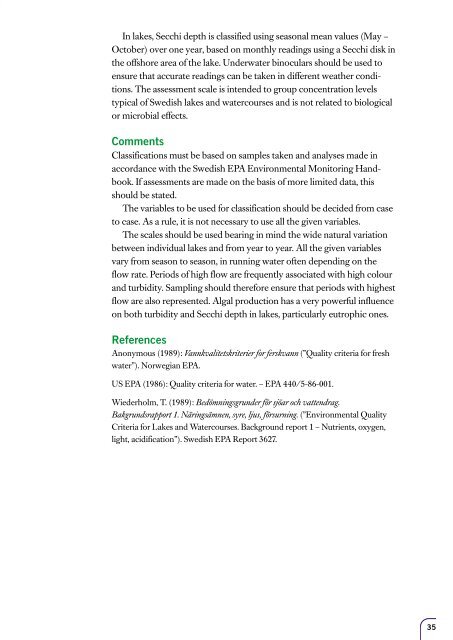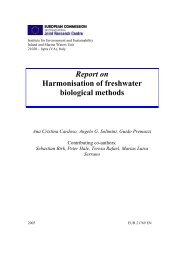Lakes and Watercourses
Lakes and Watercourses
Lakes and Watercourses
Create successful ePaper yourself
Turn your PDF publications into a flip-book with our unique Google optimized e-Paper software.
In lakes, Secchi depth is classified using seasonal mean values (May –<br />
October) over one year, based on monthly readings using a Secchi disk in<br />
the offshore area of the lake. Underwater binoculars should be used to<br />
ensure that accurate readings can be taken in different weather conditions.<br />
The assessment scale is intended to group concentration levels<br />
typical of Swedish lakes <strong>and</strong> watercourses <strong>and</strong> is not related to biological<br />
or microbial effects.<br />
Comments<br />
Classifications must be based on samples taken <strong>and</strong> analyses made in<br />
accordance with the Swedish EPA Environmental Monitoring H<strong>and</strong>book.<br />
If assessments are made on the basis of more limited data, this<br />
should be stated.<br />
The variables to be used for classification should be decided from case<br />
to case. As a rule, it is not necessary to use all the given variables.<br />
The scales should be used bearing in mind the wide natural variation<br />
between individual lakes <strong>and</strong> from year to year. All the given variables<br />
vary from season to season, in running water often depending on the<br />
flow rate. Periods of high flow are frequently associated with high colour<br />
<strong>and</strong> turbidity. Sampling should therefore ensure that periods with highest<br />
flow are also represented. Algal production has a very powerful influence<br />
on both turbidity <strong>and</strong> Secchi depth in lakes, particularly eutrophic ones.<br />
References<br />
Anonymous (1989): Vannkvalitetskriterier for ferskvann (”Quality criteria for fresh<br />
water”). Norwegian EPA.<br />
US EPA (1986): Quality criteria for water. – EPA 440/5-86-001.<br />
Wiederholm, T. (1989): Bedömningsgrunder för sjöar och vattendrag.<br />
Bakgrundsrapport 1. Näringsämnen, syre, ljus, försurning. (”Environmental Quality<br />
Criteria for <strong>Lakes</strong> <strong>and</strong> <strong>Watercourses</strong>. Background report 1 – Nutrients, oxygen,<br />
light, acidification”). Swedish EPA Report 3627.<br />
35















![Accommodation booking form [PDF]](https://img.yumpu.com/39471785/1/184x260/accommodation-booking-form-pdf.jpg?quality=85)

